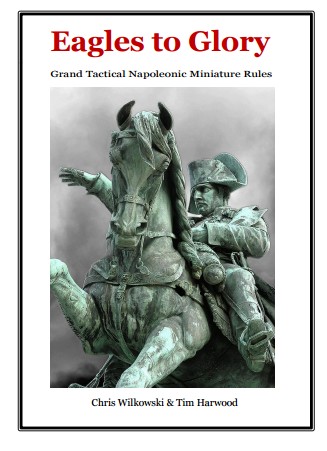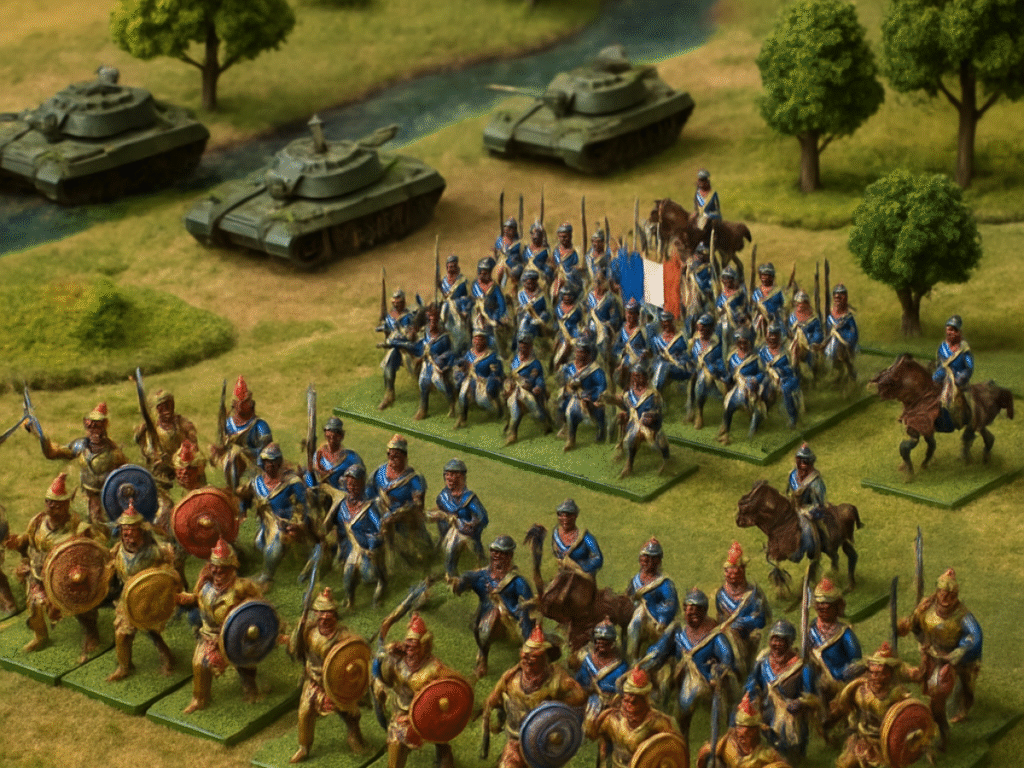Wargaming the Napoleonic era has long challenged players to balance historical authenticity with playability. Enter Eagles to Glory rules—a newly published ruleset from Chris Wilkowski and Tim Harwood that aims to capture the sweep and structure of grand tactical warfare without bogging players down in endless charts or micro-mechanics.
After reading through the full 2025 release and trying out its signature scenario, “Eagles on the Danube,” here’s what we found.
🧠 Designed for Tactical Thinkers, Not Rules Lawyers
At its core, the Eagles to Glory rules places emphasis on Napoleonic tactics over rules mastery. The system encourages historical decision-making—deploying reserves effectively, combining arms, and managing cavalry charges at the right moment. A player wins by thinking like a corps commander, not focusing on unit stats or individual formations.
A battalion, cavalry squadron, or artillery battery is represented by a single stand, which keeps play snappy and allows players to command divisions and corps with manageable tabletop footprints. And with no need for rebasing, it’s refreshingly flexible—compatible with 2mm through 28mm figures.
Although we play virtually, primarily in Tabletop Simulator, this rules set allows a new gamer to get up and going on a real tabletop with less figures… or possibly even with other miniature solutions.
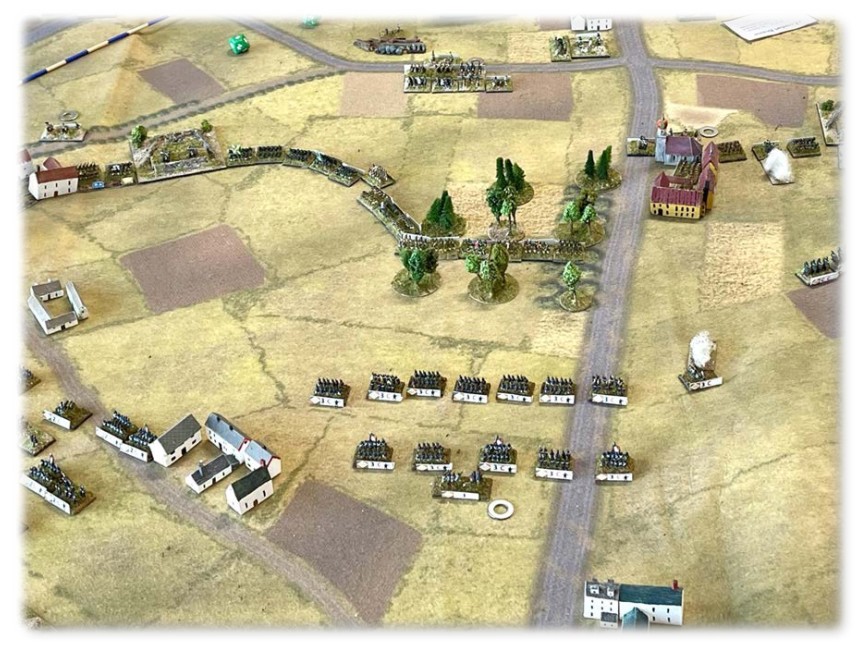
🔄 A Turn System That Flows Like a Battle
The turn sequence in the Eagles to Glory rules set is intuitive and dynamic:
- Issue Orders
- Determine Initiative
- Bombardment and Skirmish Fire
- Alternating Movement (Side A then B)
- Cavalry Charges
- Combat Resolution
- Record & Repeat
This loop feels natural and rewards foresight—especially as movement, combat, and order issuance are tied to a clever resource mechanic called Division Points (DPs). These points represent a division’s endurance and morale throughout the day of battle. Managing DPs becomes a subtle but essential layer to the strategy.
You can waste DPs by activating a division that does not need to act during the move. But, not activating a division at the beginning of the turn may cost you the opportunity to take advantage of an enemy’s mistake. This is especially true of cavalry charges.
So, planning ahead is important to managing your resources AND ultimately winning on the battlefield.
Tabletop Observation:
In the Eagles to Glory rules, players aren’t bogged down with endless unit bookkeeping. Each unit stand only needs three key pieces of information: its quality rating, any special traits (like skirmishers, lancers, or horse artillery), and its division ID. That’s it. With so few stats to track, the focus stays firmly on maneuver, tactics, and big-picture decision-making, making the game exceptionally quick to learn and effortless to run on the tabletop.
Very few markers are required on the table – a ‘fired’ marker, ‘disordered’ marker, a ‘charge’ indicator for cavalry, and a ‘square formation’ marker.
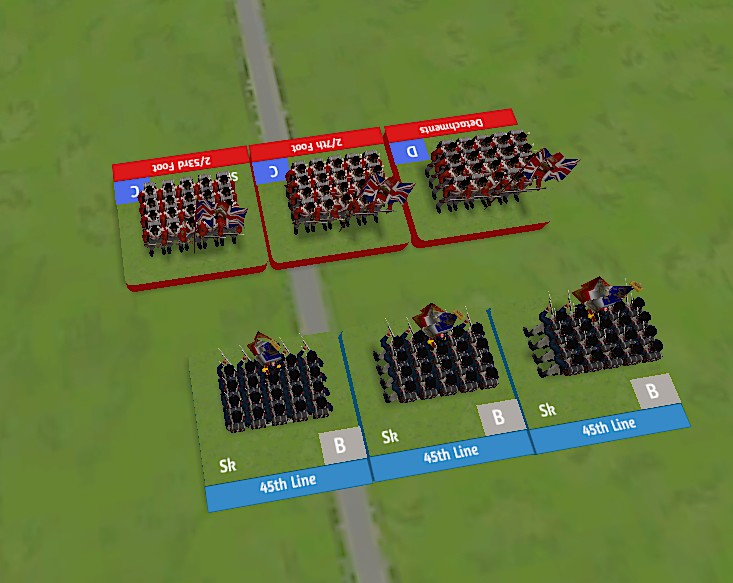
🎯 Smart Mechanics in Service of Grand Play
Some standout features of the Eagles to Glory rules include:
- Command & Control Radius reflects national army efficiency, with France (naturally) enjoying the best flexibility.
- Eagle Cards, an optional bonus mechanic, introduce fog-of-war moments, leadership flair, and reroll opportunities.
- Cavalry Mechanics are among the most satisfying we’ve seen, with detailed rules for charge declarations, opportunity charges, and breakthrough moves.
- No overly granular stat charts—combat results are streamlined through a single d20 CRT with intuitive modifiers based on unit class, terrain, and formation.
Tabletop Observation:
Unlike many wargames that demand handfuls of dice for every volley or melee, the Eagles to Glory rules keep things refreshingly simple. Each player only needs one D10 for command activation rolls and one D20 for combat resolution—nothing more. This streamlined approach speeds up play, reduces table clutter, and ensures the action flows smoothly without constant pauses to gather and roll buckets of dice.
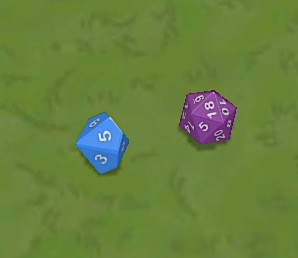
🌍 Campaign & Scenario Support
The authors of the Eagles to Glory rules have committed to releasing new scenarios on a regular basis. The first scenario, including in the rules book, is the “Eagles on the Danube” scenario (shown below), which you can download here. This scenario pits Davout’s French III Corps against Hohenzollern’s Austrians. It’s well-balanced and teaches all the core systems effectively.
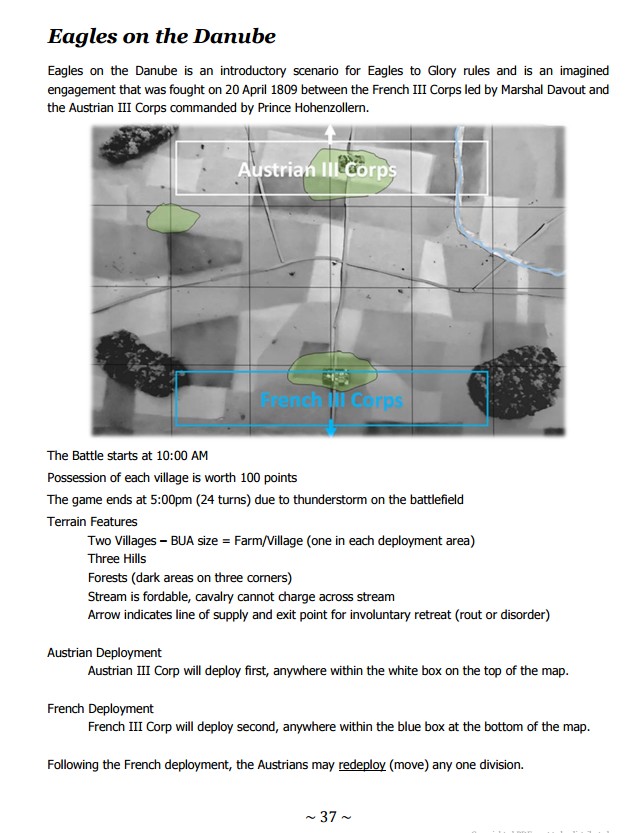
Built-in support for campaign play also makes Eagles to Glory stand out for solo and long-term players. It includes:
- Casualty recovery over time
- Movement rates by nationality
- Weather effects
- Supply logistics and victory points tied to wagons
- Even engineer units for fortifications and bridges
🧰 Tools & Templates Galore
A suite of helpful assets is available via the Eagles to Glory Facebook group, including:
- Quick Reference Sheets for different scales (75, 100, and 150 yards/inch)
- Unit labels and basing guides
- Division Point trackers (either physical stands or printable sheets)
These materials help smooth the onboarding process and make the game more accessible to newcomers. And game designers, Tim and Chris, are quick to provide feedback and clarification through the Facebook group.
📏 Verdict: Smart, Streamlined, Satisfying
The Eagles to Glory rules set does an excellent job delivering a game that rewards historical play without sacrificing speed or fun. It’s ideal for players who want to command at the division and corps level without getting bogged down in minutiae.
Recommended for:
✅ Players seeking grand tactical Napoleonic battles – up to multiple Corps per side
✅ Groups wanting scenario or campaign depth
✅ Solo players using point-based or map campaigns
✅ Anyone tired of flipping through rulebooks mid-turn
Not for:
❌ Skirmish or small unit enthusiasts
❌ Players requiring hex-and-counter precision (Although we have played a hex-and-counter version with few very few rules modifications)
❌ Groups who prefer abstracted or highly narrative play
🦅 Final Rating: 9/10
Eagles to Glory is a soaring success for historical tabletop generals who want substance, style, and scalability. It’s one of the most thoughtful Napoleonic rulesets we’ve seen in recent years—and it deserves a place in your collection.
Note – None of the links in this article are affiliated links.

